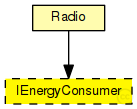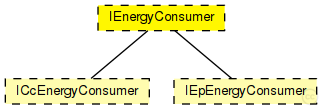 This documentation is released under the Creative Commons license
This documentation is released under the Creative Commons licenseThe energy consumer models describe the energy consumption process of devices over time. For example, a radio consumes energy when it transmits or receives signals, or a CPU consumes energy when the network layer processes packets, or a display consumes energy when it's turned on, etc.
See also: IEnergySource, IEnergyGenerator, IEnergySink, IEnergyStorage, IEnergyManagement
Author: Levente Meszaros

The following diagram shows usage relationships between types. Unresolved types are missing from the diagram.

The following diagram shows inheritance relationships for this type. Unresolved types are missing from the diagram.

| Name | Type | Description |
|---|---|---|
| ICcEnergyConsumer | module interface |
This interface extends the corresponding energy model interface. It requires implementations to describe energy consumption and energy generation with current [A], and storage capacity with charge [C] and output voltage [V]. The Cc is an abbreviation that is used for charge and current based interfaces. |
| IEpEnergyConsumer | module interface |
This interface extends the corresponding energy model interface. It requires implementations to describe energy consumption and energy generation with power [W] and storage capacity with energy [J]. The Ep is an abbreviation that is used for energy and power based interfaces. |
| Name | Type | Description |
|---|---|---|
| Radio | compound module |
The radio model describes the physical device that is capable of transmitting and receiving signals on the medium. It contains an antenna model, a transmitter model, a receiver model, and an energy consumer model. |
| Name | Value | Description |
|---|---|---|
| display | i=block/plug |
// // The energy consumer models describe the energy consumption process of devices // over time. For example, a radio consumes energy when it transmits or receives // signals, or a CPU consumes energy when the network layer processes packets, // or a display consumes energy when it's turned on, etc. // // @see ~IEnergySource, ~IEnergyGenerator, ~IEnergySink, ~IEnergyStorage, ~IEnergyManagement // @author Levente Meszaros // moduleinterface IEnergyConsumer { parameters: @display("i=block/plug"); }